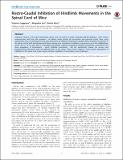| dc.contributor.author | Caggiano, Vittorio | |
| dc.contributor.author | Bizzi, Emilio | |
| dc.contributor.author | Sur, Mriganka | |
| dc.date.accessioned | 2014-07-08T15:35:14Z | |
| dc.date.available | 2014-07-08T15:35:14Z | |
| dc.date.issued | 2014-06 | |
| dc.date.submitted | 2014-01 | |
| dc.identifier.issn | 1932-6203 | |
| dc.identifier.uri | http://hdl.handle.net/1721.1/88186 | |
| dc.description.abstract | Inhibitory neurons in the adult mammalian spinal cord are known to locally modulate afferent feedback - from muscle proprioceptors and from skin receptors - to pattern motor activity for locomotion and postural control. Here, using optogenetic tools, we explored how the same population of inhibitory interneurons globally affects hindlimb movements in the spinal cord of both anesthetized and freely moving mice. Activation of inhibitory interneurons up to the middle/lower spinal cord i.e. T8–T9, were able to completely and globally suppress all ipsilateral hindlimb movements. Furthermore, the same population of interneurons - which inhibited movements - did not significantly change the sensory and proprioceptive information from the affected limbs to the cortex. These results suggest a rostro-caudal organization of inhibition in the spinal cord motor output without modulation of ascending sensory pathways. | en_US |
| dc.description.sponsorship | National Science Foundation (U.S.) (NSF IIS-0904594) | en_US |
| dc.language.iso | en_US | |
| dc.publisher | Public Library of Science | en_US |
| dc.relation.isversionof | http://dx.doi.org/10.1371/journal.pone.0100865 | en_US |
| dc.rights | Creative Commons Attribution | en_US |
| dc.rights.uri | http://creativecommons.org/licenses/by/4.0/ | en_US |
| dc.source | PLoS | en_US |
| dc.title | Rostro-Caudal Inhibition of Hindlimb Movements in the Spinal Cord of Mice | en_US |
| dc.type | Article | en_US |
| dc.identifier.citation | Caggiano, Vittorio, Mirganka Sur, and Emilio Bizzi. “Rostro-Caudal Inhibition of Hindlimb Movements in the Spinal Cord of Mice.” Edited by Simone Di Giovanni. PLoS ONE 9, no. 6 (June 25, 2014): e100865. | en_US |
| dc.contributor.department | Massachusetts Institute of Technology. Department of Brain and Cognitive Sciences | en_US |
| dc.contributor.department | McGovern Institute for Brain Research at MIT | en_US |
| dc.contributor.department | Picower Institute for Learning and Memory | en_US |
| dc.contributor.mitauthor | Caggiano, Vittorio | en_US |
| dc.contributor.mitauthor | Sur, Mriganka | en_US |
| dc.contributor.mitauthor | Bizzi, Emilio | en_US |
| dc.relation.journal | PLoS ONE | en_US |
| dc.eprint.version | Final published version | en_US |
| dc.type.uri | http://purl.org/eprint/type/JournalArticle | en_US |
| eprint.status | http://purl.org/eprint/status/PeerReviewed | en_US |
| dspace.orderedauthors | Caggiano, Vittorio; Sur, Mirganka; Bizzi, Emilio | en_US |
| dc.identifier.orcid | https://orcid.org/0000-0002-7644-4498 | |
| dc.identifier.orcid | https://orcid.org/0000-0003-2442-5671 | |
| mit.license | PUBLISHER_CC | en_US |
| mit.metadata.status | Complete | |
